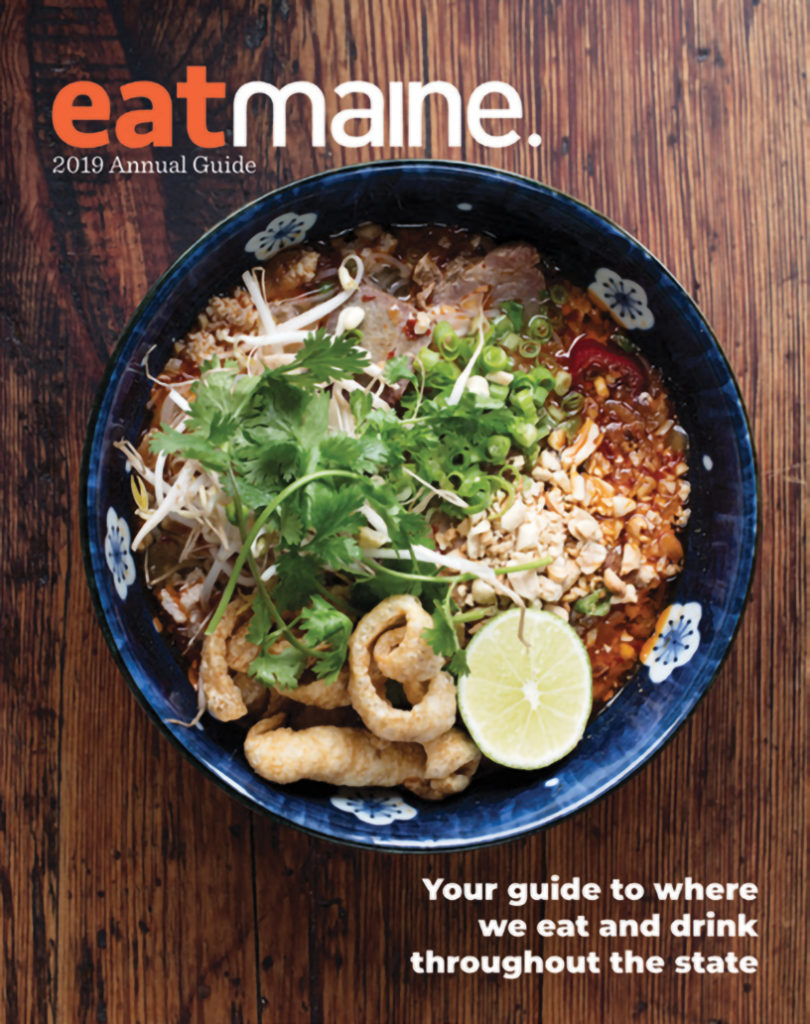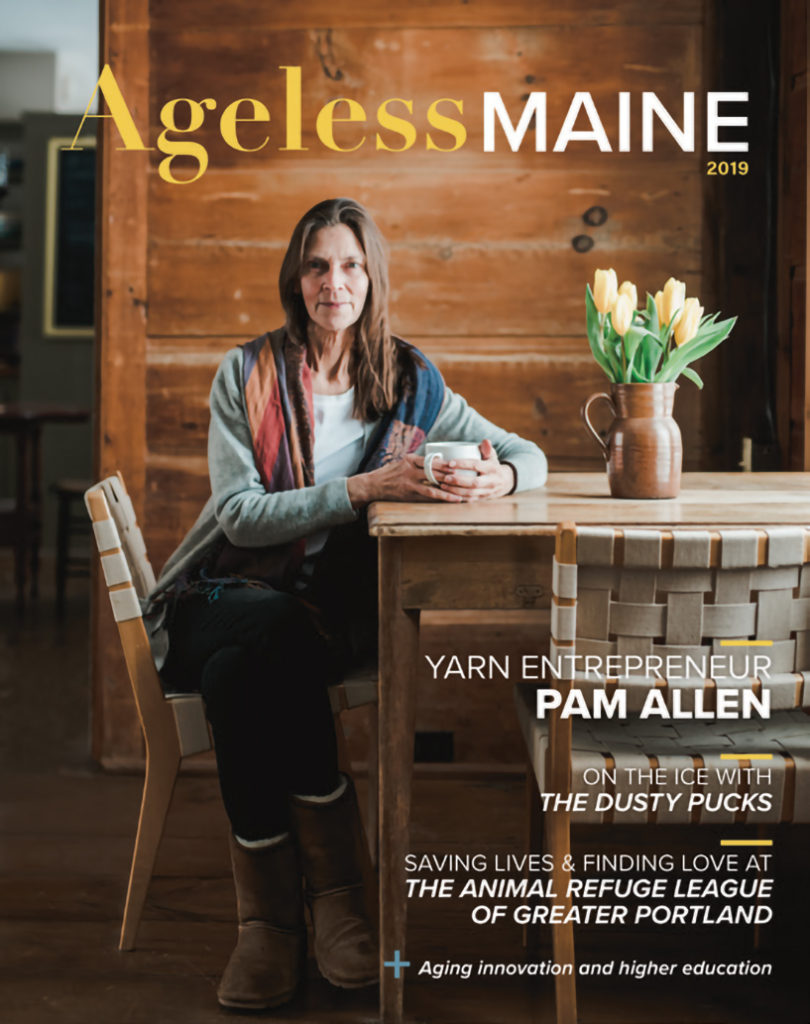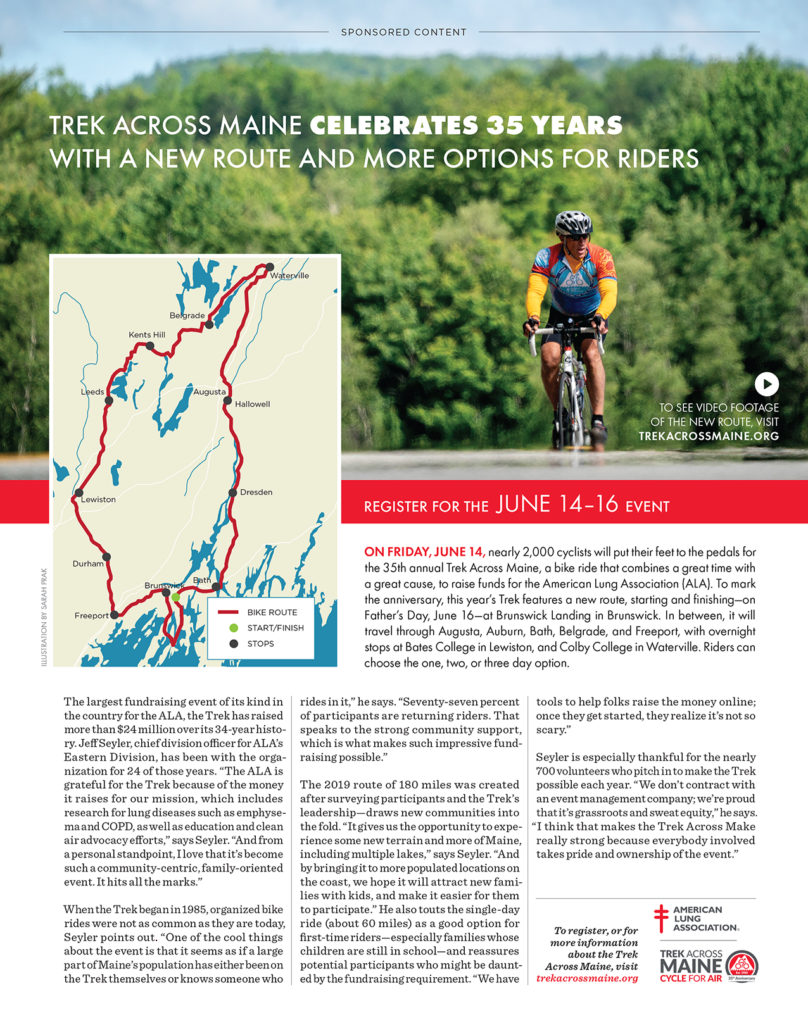
State 23 Media’s two flagship publications
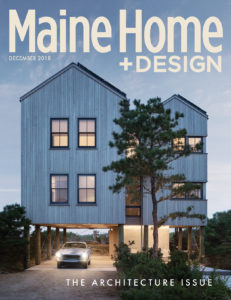
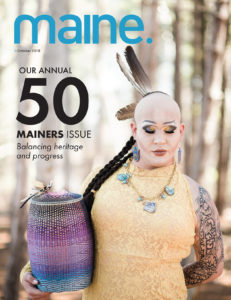
State 23 also publishes a collection of eight annual guides, of which these titles are a sampling. Because these guides align with State 23’s mission and are profitable, they survived a hard but necessary cut in the publisher’s offerings.
In the process of rebuilding advertiser relationships and forging new ones, State 23 introduced new sponsored content options in its print magazines. The staff creates custom content for projects like this one for the American Lung Association, promoting its Trek Across Maine event.
Another example of sponsored content, this one features an interview with the founder of local business Hay Runner.
State 23 staff (including Andrea King, bottom right) at the annual Shaping Maine event, which celebrates all Maine’s past and present “50 Mainers.”
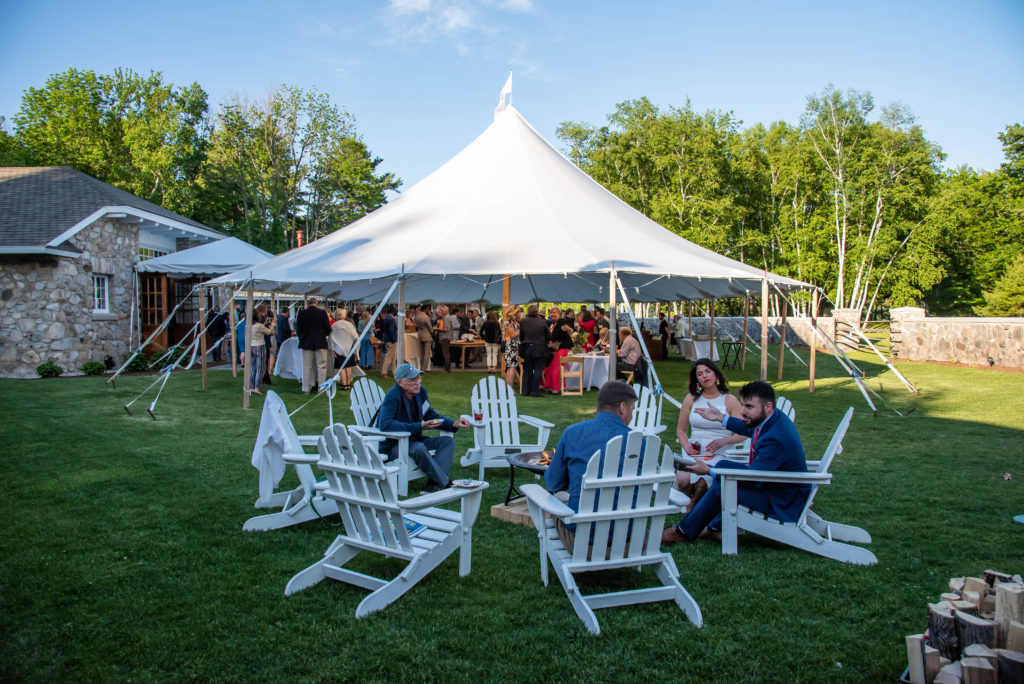
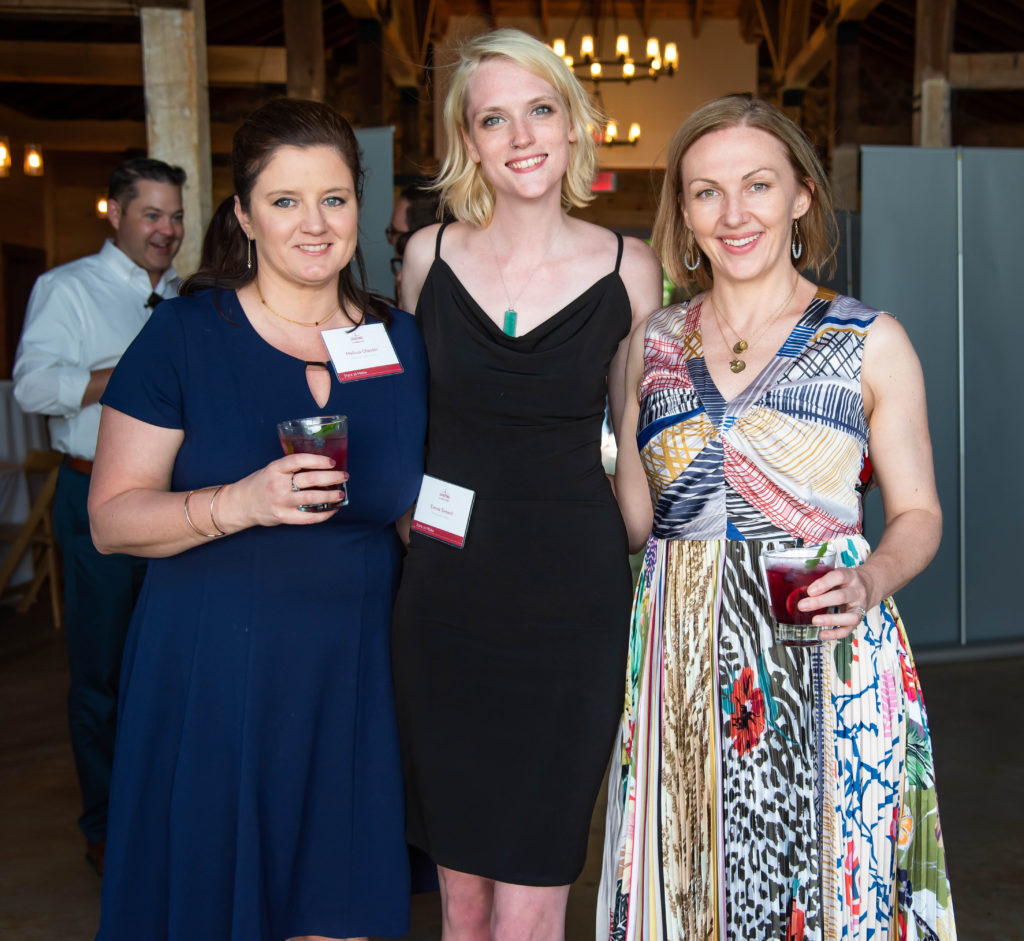
No Way to See It Coming
Overnight, we went from growth and stability to a full-blown crisis. Here’s what we did next.
By Andrea King
Magazine publishing is hard. A PR crisis makes it harder. And when that crisis leads to the cancellation of core events and the departure of key senior management and half of your advertisers … well, that goes beyond “difficult.”
I was named CEO of a Maine regional magazine publisher in November 2017, after serving as COO for a year-plus. A mere six months later, crisis hit.
As the CEO of State 23 Media (formerly Maine Media Collective), my role changed overnight — from managing the continued growth of a thriving company to suddenly controlling damage, holding together strained relationships, and buoying staff morale. At the same time, we needed to save the business. Most of my attention had to be focused on securing new owners for our magazines and related assets — the only option after receiving much negative press. And we did it. We sold the company’s assets in under five weeks to an investor group with deep experience in the media industry; its brilliant members include the former president of TIME and Sports Illustrated magazines. We then became State 23 Media.
We are a multimedia company that publishes two monthly magazines (Maine and Maine Home+Design) and eight annual guides, and produces 25+ live events per year. We are a much smaller company than before the crisis, when we also had a full-service marketing and branding business, a weekly radio show, the biggest food and wine festival in the state, and two art galleries.
In the middle of the crisis, someone said to me, “Think of this like launching a start-up. You’ve done that before — channel those skills, and you’ll be fine.” I am an entrepreneur. I studied entrepreneurship during my MBA at London Business School. I had launched a successful start-up. But rebuilding and fixing a business that has gone through turmoil is more challenging than launching a new one because there’s no clean slate. You have to clean it.
In a post-crisis situation, your team is defeated, scared, and exhausted. They’re facing an uphill climb just to get back to where they were. On the flipside, however, my team and I believed in our strengths and position in the market. We all knew how good our culture, revenue, reader-engagement, product visibility, and market share could be if we could just get past this upheaval.
And there were silver linings — lessons learned and opportunities for positive change. In many ways, the dramatic transition was a blessing in disguise. With a full-year perspective on it, I see five opportunities that arose. And because we leveraged them, they made us a stronger company.
OPPORTUNITY 1: (Re)Identify the Core Mission and Brand
It’s inevitable. People will criticize you during and after a PR crisis. In the newspaper, on social media, in casual conversations. It’s frustrating. But it gives you the opportunity to ask, who are we, anyway? What’s true, and what’s false? What was our past, and what is our future? Most critically, who do we want to be as a brand going forward?
After our PR response was under control, we took our team offsite for an intensive session to talk about our mission. We discussed what makes us special in the marketplace. We agreed that our overall strength is being a connector and influencer in the community and for our advertisers, with a focus on elevating the state of Maine. We didn’t want to lose that.
We talked about how to ensure that this mission is embedded in everything we do. We articulated the central values for each of our assets, so we’d be able to assess opportunities against them. If a story doesn’t hit each of the values for that product, we won’t publish it. In Maine magazine, for example, a story needs to provide a deeper understanding of the state’s people or resources, and be uniquely Maine. For Maine Home+Design, stories need to highlight the work of the state’s architects, builders, interior designers, artists, and craftspeople, and promote great design across the state and in a variety of disciplines.
I knew we would need all of our financial strength to rebuild our core products, the two magazines, so we identified which ancillary products were critical to our brand and which weren’t. We kept the ones that best support and strengthen who we are and are profitable, such our guides and monthly networking events. We cut the rest.
To stay focused on our mission, we also had to learn how to say no. We are constantly approached with interesting new ideas, stories, and event sponsorships. Early on, when we were desperate to rebuild broken relationships, we said yes to every opportunity for collaboration. This was a mistake. Trying to please too many parties stretched our staff and reduced the resources we needed to rebuild our core products.
We learned that everyone on our team needed to be striving for the same objective and following the same roadmap to get there. We asked ourselves these questions as each opportunity arose:
- Does this fit with our brand DNA?
- What resources does it require?
- How fast will it create revenue?
- Does it support a key advertiser or influencer agenda?
We learned to assess every opportunity in these terms. It became much easier to identify and say no to things that didn’t align with our goals. It’s always important to stay true to your brand, but in a crisis situation, when time and financial resources are even more limited, it’s critical. People are watching what you’re doing — advertisers and readers — and their future support hinges on whether you come out of this as a stronger version of your brand. Developing this kind of discipline has helped us do just that.
OPPORTUNITY 2: Improve the Culture
We know the core of any company is a team of people, so we had our company culture examined by a third-party. They conducted interviews with each individual on our staff to assess how he or she felt about our culture and to identify areas for improvement. The results were positive, with practical suggestions for improving internal communication systems. We shared this information with all external stakeholders who had questions or concerns about our culture or our ability to avoid future culture-based problems.
We also worked with an HR consultancy. Together, we assessed our HR policies and procedures, and got up-to-speed on the most current best practices. Ultimately, we implemented a more comprehensive HR policy and ensured all of our training is up to date. We also brought in an HR communication expert to teach our team positive communication techniques, which have enabled us to keep our dialogue open and honest.
Lastly, we reviewed each employee’s role in detail and provided more clarity on responsibilities and expectations. Roles change quickly in a small company, especially when staff members leave and those who remain take on new tasks. Our job profiles had become too fluid, and we were guilty of not redefining them as often as was necessary. As a result of this process, we created new systems, including quarterly, one-on-one check-ins, to keep better tabs on each role in the company. These also help our staff members see how important their jobs are in the overall operations of the company.
OPPORTUNITY 3: Clean the Slate
While you need to maintain confident optimism in a time of crisis, you can’t obfuscate. To anyone. About anything. Accountability and transparency are key to maintaining your credibility. And coming out of crisis, credibility is your most critical asset. Advertisers have to believe in you and your product; investors must see that you are capable of change and growth; and your readers and other partners have to be able to trust and respect you. We learned that in order to maintain our credibility in the process of post-crisis relationship-building, we had to:
- Be humble and honest, and not sugarcoat. People can see right through it.
- Accept responsibility. No excuses.
- Offer to answer any and all questions. Nothing was off the table.
- Ask for feedback, insight, and help. Our allies wanted to help us.
- Listen, listen, listen. People need to vent, and we learned from what they had to say.
We took purposeful steps to communicate openly and honestly with the public and our readers. I wrote a Publisher’s Note addressing the issues at hand, restating our mission and commitment, and outlining a vision for the future. After we sold the magazines to the new ownership group, we invited all stakeholders in the community — advertisers, partners, and freelancers — to a huge event that focused on the future. I made clear that we were recommitting ourselves to our mission to uplift the state and be a positive force for our community. The new owners spoke about why it was so important to save these iconic magazines and their belief in the power of local media to support community and help small businesses grow. The atmosphere at the end of the night wasn’t fully celebratory, but it certainly moved the needle from skeptical and disappointed to positive and hopeful.
Our business is built on relationships, so the most important thing we did was hold one-on-one meetings with all stakeholders. I literally sat down with advertisers, partners, and other stakeholders and said, “You can ask me anything, and I will be honest with you.” People appreciated that I took the time to validate their concerns, listen to their questions, and offer transparent, honest answers. It allowed us to hit the restart button for today’s relationships, which I’m happy to say are as strong or stronger than they were before.
Some advertisers have not come back. Of course, we’d like to say this isn’t the case. But, once again, this has been an opportunity in disguise. We focused on replacing the lost accounts with new ones. We aggressively researched opportunities, traveled throughout the state to meet companies we hadn’t worked with before, went to trade shows we hadn’t attended in the past, and offered incentives. Our business had previously been strong and stable, so we had become passive about finding new clients. Now, driven by the need to shore up our financials, we upped our game. The result? We brought on 78 new advertising clients in the first quarter of 2019 — about three times the number we had in the same period in previous years.
OPPORTUNITY 4: Re-Engage Staff
Our workforce has decreased from 30 before the crisis to 17 today. Some staff members left during the immediate aftermath, and we further reduced headcount in the effort to refocus on our core products. I don’t blame anyone who left the company during the period of uncertainty — we all considered it. But the people who stayed are fully on board with our rebuilding effort. They believe deeply in our mission and are committed to do what it takes to achieve success going forward. Combine that with the shared experience of hardship, and what we have is a group with strong bonds, increased loyalty, improved collaboration, and excellent communication.
Despite everyone working additional hours and giving extra effort, we couldn’t pay bonuses or give raises last year (and that may happen again this year) because we haven’t fully recovered financially. So, we’ve had to find different ways to maintain morale.
For example, we used to have a monthly offsite meeting after uploading the magazine issues to discuss big-picture strategy, such as new product ideas or where we want to be in five years. We’ve now added an afternoon of fun to these events, with team-building games and bowling or boating. This gives us a change to de-stress and laugh together.
Partly socially engineered and partly financially required, we also moved to smaller offices with open floor space. This was an adjustment, but it has led to increased and improved collaboration. And we have incorporated flex-time schedule and work-from-home policies to accommodate different needs and work styles. It has resulted in a more stable work environment, where team members are focused on growing our business.
OPPORTUNITY 5: Strengthen Advertiser Programs
Our revenue comes almost exclusively from advertisers, not subscriptions, so it’s critical that we maintain positive, constructive relationships. And that we ensure our advertisers’ investments produce positive results for them. In that spirit, we have always looked for ways to collaborate with sponsors and advertisers around content, long before native advertising and sponsored content became common in publishing.
This is tricky territory. To maintain credibility as a magazine, there has to be a divide between sales and editorial, but building that wall with iron is a poor business practice. We are a small team in a small state. We serve small companies. To ignore the benefits of collaborating with these businesses would be shortsighted.
Advertising in our magazines will not get you editorial coverage. But it will get you invited to our events; we’ll follow you on social media; and we’ll think of ways to help grow your business. For example, we’ll introduce you to other businesses you should know, and we’ll thoughtfully consider ways we can help you market your products and services, like suggesting upcoming trade shows, developing new ideas for your ads, or brainstorming sponsored content projects. With Maine Home+Design, deeper relationships with advertisers help our editorial team find story ideas, such as architect-designed homes to profile, that naturally align with our editorial vision and would otherwise be hard to discover.
During the one-on-one rebuilding conversations we had with advertisers, it became clear that many want to tell their stories in innovative ways. Certainly, a smart, well-designed ad can speak to a target audience, but some advertisers want us to help them tell a longer story or go deeper into an issue. With our more responsive approach in the post-crisis era, we have introduced attractive and clearly labeled sponsored content options for our clients in both print and online, ranging from Q&As with business owners to full features written by our special projects editor. These have been extremely well received by clients, adding revenue to the business and allowing us to offer yet more options to our clients.
~
Almost going under gave me the opportunity to get comfortable with risk. Knowing the worst outcome was that the magazines might fold and my team and I would be unemployed gave me a strange comfort. No one was sick. It wasn’t the end of the world. We would all find other jobs. With that as the worst possible outcome, I felt comfortable taking bigger risks (still sensibly assessed), making bolder statements (that were “on brand”), and being radically candid (which was refreshingly welcomed). For example, in our annual 50 Mainers issue last year, we chose a striking portrait for the cover — a Passamaquoddy basket maker and drag performer who uses the gender-neutral pronoun “they.” This is a cover we probably wouldn’t have chosen in the past. We previously avoided supporting organizations that took too much of a stance, but we now happily sponsor them. This year, we created a quarterly speaker series to help business leaders in our community improve equality in the workplace with actionable tactics and to boldly, yet humbly, push for progress on diversity and equality for gender, race, immigrant status, and age. As a result of this series, we were able to rebuild one of our most important nonprofit relationships. They saw us in action, living up to our mission to elevate the state, and this spoke louder than any words we could have said.
I’m proud of the work we did to rebuild this media company. And with reputation restored and sales growing, I’m now passing the reigns on to our incredible and capable staff. I am leaving State 23 to move my family back to my hometown. Two individuals from our ownership team, Sandy Spaulding and Bruce Hallett, have stepped in as on-the-ground managing partners to continue this positive trajectory.
We are all in the story-telling business. Lisa Cron, author of Wired for Story says, “Story, as it turns out, was crucial to our evolution — more so than opposable thumbs. Opposable thumbs let us hang on; story told us what to hang on to.” So I would say, own your story, even in crisis. We did – and we used it to motivate and inspire us to emerge from this challenge stronger than we were before it.
Andrea King, former publisher and CEO of State 23 Media, has happily relocated to her home turf in beautiful St John, Newfoundland. She was named by Folio: as a 2019 Top Women in Media honoree. This award recognizes trendsetters, entrepreneurs, change-makers, and industry innovators. Connect via king@pagesthemagazine.com.



